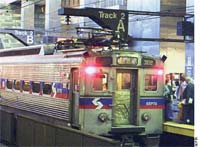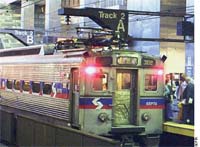
Solving Noise Hazards of Railroads
The 2006 Federal Railroad Administration rule resembles OSHA's Hearing Conservation Standard but places a higher priority on engineering controls.
- By Renee S. Bessette, COHC
- Jun 01, 2008
 As we travel during the course of the day,we are
often exposed to the sounds of the environment:
trucks and buses honking horns, subways
screeching around corners, and trains
blowing their whistles at crossings. All these modes of
transportation use sound to help keep people aware of
their presence and safe from it.And while many of these
noises are loud, few are hazardous to those in the vicinity.
However, that is not always the case for those operating
and managing them.
As we travel during the course of the day,we are
often exposed to the sounds of the environment:
trucks and buses honking horns, subways
screeching around corners, and trains
blowing their whistles at crossings. All these modes of
transportation use sound to help keep people aware of
their presence and safe from it.And while many of these
noises are loud, few are hazardous to those in the vicinity.
However, that is not always the case for those operating
and managing them.
For example, noise pollution in areas surrounding
airports has long been a controversial topic, but the people
most at risk from aircraft noise are the people who
work closest to them: ground crews, mechanics, baggage
handlers, maintenance workers, and others. This is not
surprising when you consider the sound of a jet engine
can easily reach 140 decibels (dB), well above the pain
threshold and loud enough to cause hearing damage
after only a few minutes of unprotected exposure.Cabin
noise levels in a typical jet engine aircraft at takeoff have
been measured between 95 and 98 dB. Turboprop takeoff
noise can reach 110 dB, and in-flight noise can reach
90 dB or more for both passengers and crew.
Hearing conservation programs in transportation industries
must do double duty. They must protect workers
from hazardous noise but also ensure their ability to
communicate clearly in their surroundings. The difference
between hearing and not hearing a signal to release
a brake could mean life or death for transportation workers,
passengers, and bystanders.
The Federal Railroad Administration’s Rule
While OSHA covers general industry, aviation, trucking,
and bus transportation, the Federal Railroad Administration
(FRA) has specific safety standards for freight and
passenger railroads and commuter rail. Its Office of Safety
focuses on the protection of more than 80,000 railroad
employees in the United States as well as passengers, ensuring
that people and products arrive at their destination
in a safe and timely manner.
In 2006, the FRA issued a new standard for occupational
noise exposure among railroad workers. This standard,“
49 CFR Parts 227 and 229 Occupational Noise Exposure
for Railroad Operating Employees,”is very similar
to the OSHA Hearing Conservation Standard, except
that it places a higher priority on engineering controls.
The standard was promulgated by the Railroad Safety Advisory Council (RSAC), which included members
from the industry, labor, manufacturers/suppliers, and
occupational noise experts. Locomotive engineers, audiologists,
and other safety professionals also provided
input in developing this standard.
FRA prefaced its ruling with the acknowledgement
that “noise is one of the most intrusive aspects of locomotive
operations.”Noise sources span a range of engineered
sources, such as engines, horns, and brakes; organic
sources, such as cab vibration and reflected noise
from open windows; and other types of continuous, intermittent,
and impact noise.
Just as with the OSHA standard, railroad operators
must implement a hearing conservation program when
noise levels meet or exceed 85 dBA (8-hour TWA, or
Time Weighted Average). The program must include
dosimetry (area and personal), audiometry, availability
of hearing protection and its mandatory use at 90 dBA,
employee training, and recordkeeping.
Unlike OSHA, FRA has a few deviations in its hearing
conservation program that focus on the mechanical
and less on the personnel/personal.For example, railroad
workers are mandated to undergo audiometric testing
only once every three years, thus making the detection of
noise-induced hearing loss a longer process.
Noise Operational and Engineering Controls
While use of hearing protection devices is mandatory for
worker noise exposure of 90 dBA or higher (8-hour
TWA), FRA allows “the option of using noise operational
controls when employees are exposed to noise levels that
exceed 90 dB(A) as an 8-hour TWA.”To promote the use
of quieter equipment and eliminate the need for worker
use of hearing protection, the standard states that railroads
must “obtain and maintain locomotives built to
meet the performance standard for maximum noise level
in the cab defined by standards in 229.121.”
As a result of concern for worker exposure and in response
to the need for more efficient equipment, new locomotive
cabs are now being designed to reduce worker
noise exposure levels and keep them under the 90 dBA
for an 8-hour TWA. This engineering includes moving
the placement of horns and brakes away from workers
and better cab insulation to keep noise out. At the same
time, railroads are forced to place a higher priority on
maintaining older equipment to ensure it works efficiently
and more quietly.
The FRA standard also states that any hearing protection
device (HPD) used must not interfere with
crew/radio communications. To avoid overprotection,
engineering controls place less responsibility on employees
to wear HPDs.
To ensure worker use, FRA does require railroad employees
to adhere to the standard, especially in the use of
hearing protectors and training. Violation of this standard
could result in penalties.
Best Practices: SEPTA
About 600 of the 10,000 employees of the Southeastern
Pennsylvania Transportation Authority (SEPTA) are in
its hearing conservation program. These employees include
engineers, mechanics, infrastructure repair workers,
and conductors.
“To maintain track, power, and signals, we need to
maintain the health and well-being of our employees.
It can be a noisy industry,” said Sharon Sperber, CIH,
Safety Officer at SEPTA. “We want to make sure that
any [noise-induced hearing loss] is not an occupational
injury.”
SEPTA offers its employees a variety of foam ear plugs
and ear muffs so workers can choose what they want to
wear.When the HPDs are dispensed, each employee receives
one-on-one training in proper fit and use of the
protectors. To encourage the proper use of protection, SEPTA also uses signs to identify where hearing protection
is needed in noisy areas.Employees also will find the
class/lot numbers of the ear plugs or ear muffs at hearing
protection stations, making reordering easy when inventories
are low.
SEPTA also uses the influence of peers to promote
proper hearing protection and other PPE use at each location,
giving ownership of personal safety to the employees
and making safety everyone’s responsibility. This
approach utilizes each location’s safety committee comprised of the site manager, a facilities representative,
and three to four employees—to be a resource for other
employees. These committee members can field questions
and act as a positive influence on others.
In line with FRA’s rule, SEPTA will go online with
new rail equipment in 2010 that has been designed to
be much quieter. The intent is to engineer out the noise
and the need for hearing protection. Current locomotive
cabs are also outfitted with air conditioning, alleviating
the need to open windows and expose engineers
to hazardous noise.
Passengers and Hearing Protection
Not only are transportation workers exposed to potentially
hazardous noise levels; passengers are, as well.
While most noise levels that passengers are exposed to are
less than 85 dB, they are exposed to nuisance noise, such
as horns, brakes, and other commuters’ conversations.
Passengers often act on their own to manage their exposure
to nuisance or hazardous noise by using:
Active noise reduction headsets. Also known as
“noise canceling headsets,” these ear muff-style devices
attenuate low frequencies, up to 1000 Hz.Active noise reduction
headsets provide a quieter environment without
total isolation. These are ideal for commuters on subways,
commuter rail, and airplanes and can be plugged
into MP3 players.
Ear plugs. Some people take their commute as time
to mentally prepare for the day or relax on the way home.
Ear plugs offer a higher level of noise-blocking protection,
avoidance of most general ambient nuisance noises,
and a high degree of comfort when properly fitted.
MP3 players. Those who use MP3 players for personal
listening enjoyment to counteract transit nuisance
noise often turn the volume up on their devices,
potentially exposing themselves to even more hazardous
noise levels.
This article originally appeared in the June 2008 issue of Occupational Health & Safety.